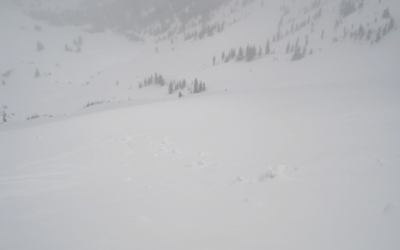
As I’ve been telling you since I first ascending this pulpit, there is nothing you can do to help your skiing more than procuring a properly fit ski boot. There is no way to compensate for its absence, no alternative that makes the choice of boot immaterial. It is, in a word, essential.
Given the primordial importance of the bootfitting enterprise, I thought it might be instructive if you, Dear Reader, experienced a typical bootfitting interaction from the bootfitter’s point of view. Let’s suppose introductions are over and you’re now seated before me, eager to get the process underway.
Before I even ask you to show me your bare feet, I’ve been observing your stance and seated posture. I’m trying to gauge, in general, how much of an athlete I have in front of me. Some people glide through the world; others, shall we say, don’t. It’s too early to form judgments, of course, but information gathering starts at, “Hi, my name’s Jackson.”
I’m going to ask to see your bare feet and to take a look at whatever you brought as a ski sock. The sock will get an immediate verdict, yes, these will be fine, or no, let me get you something that will make a happy outcome more likely. Your bare feet will usually require a little re-positioning, as I want them hip-width apart, right angle at the knee and hip, feet aimed at me.
While I’m guiding your bare tootsies into a neutral position, I’m feeling for any abnormalities and asking questions like, “Any history of injury I should know about? Any areas that always give you trouble?” I’m scanning typical problem areas for telltale signs of issues I’ll have to deal with no matter what boot I target.
I’m going to measure the length of both your feet, and usually the heel-instep perimeter (HIP). Other interesting measurements – notably arch length and width – I don’t need to measure as the evidence is staring me in the face. What I can’t tell just by eyeballing are the flexibility of your arch and your ankle range of motion, so I’ll conduct a couple of 5-second tests to see how healthy and receptive to support your arches are and if your ankle ROM is compromised.
As I scan your foot and lower leg, I’m looking at how each element – calf, ankle, heel, midfoot and forefoot – looks relative to the whole. For example, if am I looking at a big piston of a calf mounted on a slender lower leg and ankle, with a high arch, how am I going to fit this amalgam? What oddity do I prioritize?
The answer is always, prioritize the bones of the rear foot. In this case, I’m going to need a low-volume shell, even though the calf and midfoot are screaming for something, anything, larger. Why do I go this route? Because the hardest part of the boot to modify is the heavily reinforced heel and ankle area, so I want the ideal match of skier and boot to be in this zone. The calf pinch I can deal with by raising the heel a tad, which will annoy the arch until I expand that area, which is easy to do, much simpler than trying to carve out new territory in the heel.
Now I’m ready to hear your skiing history, where you’ve been, where you dream of going, what runs you seek out, what you wouldn’t ski on a bet. I’m always interested in your current boots and why they’ve fallen out of favor. Is there anything in particular you want to try on, because of a friend’s recommendation or a previous, positive experience? Left to my own devices, I won’t be making a lot of trips to the stock room, so if you have a model in mind, now is the time to mention it.
A good bootfitter doesn’t just know about feet and how they behave in the hostile environment of ski boots; he or she also needs to know the strengths and weaknesses of every model in inventory. It’s the ideal marriage of boots and feet that we’re trying to consummate; the more one knows about both, the better the probable outcome.
Before I put you in the first model and size I’ve selected for you to try on, I want to revisit your arch. No matter what boot I retrieve, the insole that comes with it will be a nothing-burger, a mere placeholder for a device that actually does something. That “something” is full contact with the zillions of proprioceptors in your arch, a key component in your balance system that beg to be connected, and need support to do their job. While off-the-rack solutions can’t usually achieve the perfect match that’s attainable in a custom insole, even an approximate fit is better than the nothing-burger.
At this point, I know a lot about what boot I’m leaning towards, but there’s still one critical factor I can’t predict: your ability to flex a ski boot. Every model has a designated flex index; the higher the number, the stiffer the boot. In most cases, you want the stiffest boot you can comfortably flex forward while standing on the boot bench. The first boot I present may not be the stiffest option available, but I will be shooting for the highest flex I suspect the customer can manage.
Boot pricing is directly correlated to flex: the higher the flex number, the higher the price. Usually, each 10-point jump on the flex index triggers a $100 bump at retail. The best advice being proffered in today’s Revelation is: DO NOT GET A SOFTER BOOT JUST TO SAVE $100. The boots you buy today may be with you for the next decade. If you want to improve as a skier over that span – no matter what form said improvement may take – a closer-fitting, more supportive and more responsive boot will make it possible. The C-note you spend to get the better boot is a pittance over the lifespan of the boots and a paltry fraction of the total cost of one’s equipment, not to mention lift passes, lodging, transportation… You get the idea.
Once I have you in the right boot, in the right flex and you have solid underfoot support, we’re done. Almost. I want to see you flex the boot and rock side to side. I’m looking for stance and alignment issues that could limit your performance and/or comfort. Based on what I see, I may elect to slightly shift your ramp angle or modify your lateral cuff alignment.
That’s it. There are always other accoutrements to consider, such as a heated boot bag, a Booster strap or a custom inner boot, but job one is done and dusted. Shall we look at skis?
Related Articles
Road Tripping
Among the many dissatisfactions of this most unusual season is that travel beyond one’s local environs has been roundly discouraged. Don’t get me wrong: I’m grateful down to my socks that we’re allowed to ski locally, and my version of same is pretty sweet. Pardon the plug, but between Alpine Meadows, Squaw Valley and Mt. Rose I have a smorgasbord of savory choices.
But skiing close to home and skiing on the road are two different beasts. Nothing is the same, really, and therein lies a great deal of the road trip’s charms.
To shed light on my premise, allow me to pull back the veil on my favorite away game, an annual pilgrimage to Little Cottonwood Canyon. By the end of this brief travelogue you will probably hate me, so please fill your vessel of good will to the rim before proceeding.
It’s About Nothing
In the last week of January,2009 I was able to spend a few days skiing in Little Cottonwood Canyon, which is always cathartic for my ravaged soul. The conditions were all over the map, the mountains having experienced a long, hot spell followed by rain, grapple, wet snow and finally dry snow driven by winds that could flense an adult walrus in a few minutes. Couldn’t have been better.
I had been preparing for the trip for weeks, psychologically. Two back surgeries the previous winter had reduced my training regimen from semi-annual to non-existent. Scheduling conflicts such as work kept me from visiting the areas that abound at home near Lake Tahoe, so I had zero ski days on a body with more fat on it than a French duck. I had as much chance of surviving Snowbird and Alta as a rib roast in a piranha tank.
Fortunately, the Lord is merciful, anti-inflammatory drugs are powerful and there are techniques that allow one to block out pain. There are also many wonderful people in this world with which to ski, kind people who stand quietly by, pretending to be in awe of Nature, while my chest heaves so violently in its futile quest for oxygen that tiny lung particles break lose and make for the exits. One such person is Guru Dave Powers, a man whose passion for the sport hasn’t diminished after thousands of days of riding gravity down the infinitely variable slopes and crannies of Snowbird. The Goo knows this hill, and in knowing it well knows so much more.
The Making of a Skier, Chapter XII: Putting Words into the Mouth of God & Other Mid-Life Adventures
When I was cut adrift by Head on June 13, 2001, my once glowing prospects dimmed considerably. The date is etched in memory because I hosted a small soirée that evening in honor of my darling wife’s 50th birthday. One of the attendees was Paul Hochman, who would play several roles in my life as I wandered in the wilderness of unemployment during what were supposed to be my peak earning years.
During the gaping hole in my career that spanned 2001-2011, I would eventually spend every cent of my inheritance, plus most of what I’d saved from earlier bouts with gainful employment, just keeping the household afloat. Despite a river of red ink, my resume would suggest that I was not only commercially active during this epoch, but had my hand in all sorts of ventures.





